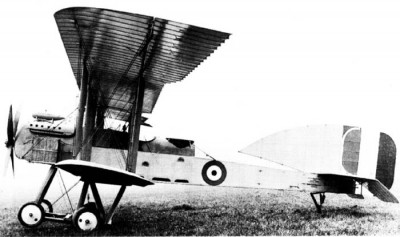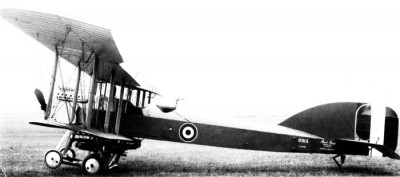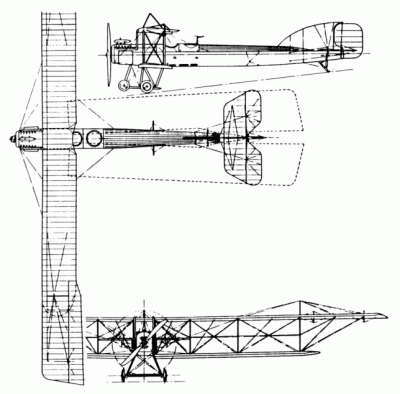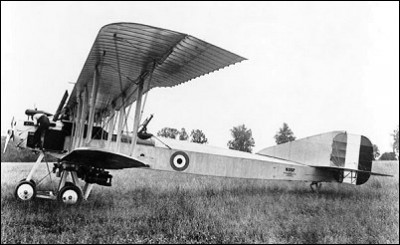| Název: Name: | Short Bomber | Short Bomber |
| Originální název: Original Name: | Short Bomber | |
| Kategorie: Category: | bombardovací letoun | bomber aeroplane |
| Výrobce: Producer: | DD.MM.1915-DD.MM.1916 Short Brothers Ltd., Rochester DD.MM.1916-DD.MM.1916 Mann, Egerton & Co Ltd., Norwich DD.MM.1916-DD.MM.1916 Parnall & Sons Ltd., Bristol DD.MM.1916-DD.MM.1916 Phoenix Dynamo Manufacturing Co Ltd., Bradford DD.MM.1916-DD.MM.1916 Sunbeam Motor Car Co Ltd., Wolverhampton | |
| Období výroby: Production Period: | DD.MM.1915-DD.MM.1916 | |
| Vyrobeno kusů: Number of Produced: | 83: 36 - Short 15 - Sunbeam 20 - Mann, Egerton 6 - Parnall 6 - Phoenix | |
| První vzlet: Maiden Flight: | DD.MM.1915 | |
| Osádka: Crew: | 2 | |
| Základní charakteristika: Basic Characteristics: | ||
| Vzlet a přistání: Take-off and Landing: | CTOL - konvenční vzlet a přistání | CTOL - conventional take-off and landing |
| Uspořádání křídla: Arrangement of Wing: | dvouplošník | biplane |
| Uspořádání letounu: Aircraft Concept: | klasické | conventional |
| Podvozek: Undercarriage: | pevný | fixed |
| Přistávací zařízení: Landing Gear: | kola | wheels |
| Technické údaje: Technical Data: | ||
| Hmotnost prázdného letounu: Empty Weight: | 2268 kg | 5000 lb |
| Vzletová hmotnost: Take-off Weight: | 3084 kg | 6800 lb |
| Maximální vzletová hmotnost: Maximum Take-off Weight: | ? kg | ? lb |
| Rozpětí: Wingspan: | 25.91 m | 85 ft |
| Délka: Length: | 13.72 m | 45 ft |
| Výška: Height: | 4.57 m | 15 ft |
| Plocha křídla: Wing Area: | 80.83 m2 | 870 ft2 |
| Plošné zatížení: Wing Loading: | ? kg/m2 | ? lb/ft2 |
| Pohon: Propulsion: | ||
| Kategorie: Category: | pístový | piston |
| Počet motorů: Number of Engines: | 1 | |
| Typ: Type: | Sunbeam Mohawk o výkonu 168 kW nebo Rols-Royce Eagle I o výkonu 186 kW dvoulistá dřevěná vtule | Sunbeam Mohawk, power 225 hp, or Rolls-Royce Eagle I, power 250 hp two-blade wooden propeler |
| Objem palivových nádrží: Fuel Tank Capacity: | ? | ? |
| Výkony: Performance: | ||
| Maximální rychlost: Maximum Speed: | 125 km/h v 1981 m | 77.5 mph in 6500 ft |
| Cestovní rychlost: Cruise Speed: | ? km/h v ? m | ? mph in ? ft |
| Rychlost stoupání: Climb Rate: | ? m/s | ? ft/min |
| Čas výstupu na výšku: Time to Climb to: | 45 min do 3048 m | 45 min to 10000 ft |
| Operační dostup: Service Ceiling: | 2896 m | 9500 ft |
| Dolet: Range: | ? km | ? mi |
| Maximální dolet: Maximum Range: | ? km | ? mi |
| Výzbroj: Armament: | 1x pohyblivý 7,87mm kulomet Lewis v zadní kabině Bomby: 4x 104 kg nebo 8x 51 kg obvyklý náklad 8x 29,5 kg | 1x flexible .303 Lewis machine gun in the rear cockpit Bombload: 4x 230 lb or 8x 112 lb usual load 8x 65 lb |
| Uživatelské státy: User States: | | |
| Poznámka: Note: | Vytrvalost: 6 h | Endurance: 6 hr |
| Zdroje: Sources: | Thetford, Owen. British Naval Aircraft since 1912, Naval Institute Press, Annapolis 1991, ISBN 1-55750-076-2. Mason, Francis K. British Bombers since 1914, Putnam, London 1994, ISBN 0-85177-861-5. www.aviastar.org http://www.airwar.ru/enc/bww1/bomber.html www.britishaircraft.co.uk/aircraftpage.php?ID=687 | |
| Period | - |
| Producer | - |
| Type | - |
| Camouflage | - |
| Country | - |
| Pilot | - |
| Production No. | - |
| Serial No. / Evidence No. | - |
| Tactical Marking / Imatriculation | - |
| Name | - |
| Unit | - |
| Base | - |
| Date (DD.MM.RRRR) | - |
| Author | - |
| Print size / 300 DPI | - |
| Published with authors permit | - |
| Author Website | - |
Prototyp s původním krátkým trupem
| Period | - |
| Producer | - |
| Type | - |
| Camouflage | - |
| Country | - |
| Pilot | - |
| Production No. | - |
| Serial No. / Evidence No. | - |
| Tactical Marking / Imatriculation | - |
| Name | - |
| Unit | - |
| Base | - |
| Date (DD.MM.RRRR) | - |
| Author | - |
| Print size / 300 DPI | - |
| Published with authors permit | - |
| Author Website | - |
Shortem vyrobený Bomber 9315, 10. vyrobený stroj s motorem Sunbeam, zde s 29,5kg bombami během testů před převzetím námořnictvem. Tento stroj patřil mezi 15 následně předaných RFC v době bitvy na Sommě.
| Period | - |
| Producer | - |
| Type | - |
| Camouflage | - |
| Country | - |
| Pilot | - |
| Production No. | - |
| Serial No. / Evidence No. | - |
| Tactical Marking / Imatriculation | - |
| Name | - |
| Unit | - |
| Base | - |
| Date (DD.MM.RRRR) | - |
| Author | - |
| Print size / 300 DPI | - |
| Published with authors permit | - |
| Author Website | - |



